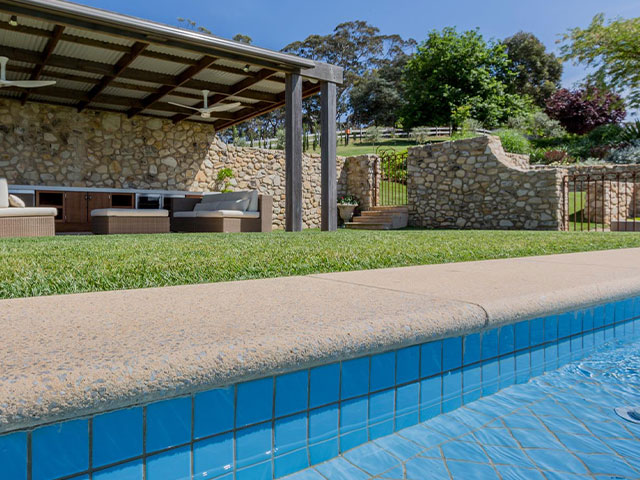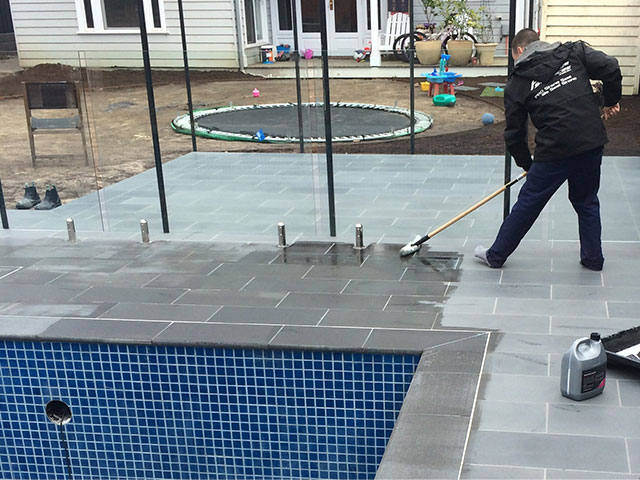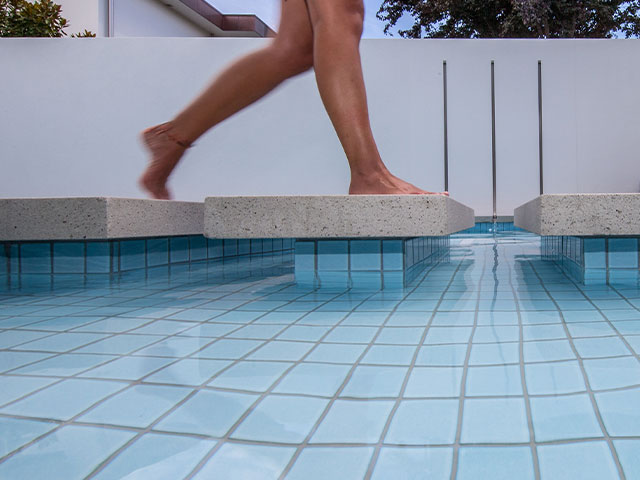When it comes to creating a beautiful and functional pool area for your home, one of the crucial decisions you’ll face is choosing the right material for the pool deck. Concrete pavers and in-situ concrete (poured on-site) are two popular options, each with a unique set of advantages and drawbacks.
So, which option is superior? In this post, we’ll delve into the pros and cons of concrete pavers and in-situ concrete for pools, helping you make an informed choice that suits your needs, aesthetics, and budget.
Aesthetics
Concrete pavers are renowned for their aesthetic versatility. They come in various shapes, sizes, colours, and textures, making it easy to create a customised look for your pool area. Whether you prefer a classic or contemporary style, pavers offer the flexibility to achieve your desired aesthetic. Different pool coping styles also allow you to customise the edges of your pool.
In-situ concrete offers a sleek, seamless appearance over a broad space, which can be appealing for modern and minimalistic pool designs. Multiple curves can be incorporated into in-situ concrete, whereas to do the same with concrete pavers, individual moulds would need to be produced for each differing radius.
While you can add colour and texture to in-situ concrete through the use of coloured oxides or special aggregate mixes, you generally won’t get the same level of design flexibility that is available when using pavers, which offer a much wider scope of design possibilities.
Installation
The installation of concrete pavers is relatively easy and quick for experienced contractors, as the process of laying each individual paver is fairly repetitive. Installation times can differ based on the paving pattern, where gridded or stretcher bond standard patterns will be much quicker to install than pavers in an ashlar pattern. Pavers are laid on a prepared base and require no time to cure, as they are only sent to site once they have achieved the required strength. This means less disruption to your outdoor space during the installation process.
Poured concrete requires significantly more time for the preparation of the formwork and curing of the concrete after it has been poured. The installation process can be more labour-intensive and time-consuming compared to pavers.
Durability
Concrete pavers are durable and can withstand freeze-thaw cycles and the pressure of heavy foot traffic. Over time, individual pavers may become uneven due to movement and de-bonding from the base, requiring occasional maintenance and adjustment. The installation process is thus critical to ensure that pavers are installed correctly with adhesion to the sub-base.
In-situ concrete is extremely durable and can last for decades with proper maintenance. It has stronger resistance to movement and cracking, especially when control joints are properly implemented. However, if cracks do occur within the concrete, they can be challenging to repair seamlessly.
Maintenance
If a paver gets damaged or requires replacement, it can easily be replaced without much effect to the surrounding area, as only the affected individual pavers needs to be replaced and re-grouted. However, there is likely to be slight colour discrepancies between the existing pavers and new replacement pavers, due to the natural weathering of concrete. For pavers on pedestal systems, the replacement process is even simpler. This ease of repair minimises long-term maintenance costs.
Concrete requires less frequent maintenance than pavers, but if it does crack or develop issues, repairs can be more complex. Repairing these areas might lead to visible patches, detracting from the overall aesthetic.
Whether it’s in-situ concrete or concrete pavers, keeping the pool area routinely cleaned and properly sealed can help prevent stains and maintain the appearance of the concrete over time.
Safety
In-situ concrete can become slippery when wet, making it less ideal for pool areas without additional treatments or textured finishes.
Concrete pavers are produced with a shot-blasted, textured finish that reduces the risk of slipping, even when wet. Given their non-slip surface, pavers are generally safer for installation in pool areas.
Cost
Concrete pavers require a higher initial investment due to the cost of materials and labour. However, they offer a more customizable and visually appealing solution with long-term benefits such as ease of maintenance and spot replacements.
In-situ concrete tends to be more cost-effective, especially for larger areas, but this comes at the price of lower design flexibility and fewer aesthetic choices compared to pavers.
Verdict
The choice between concrete pavers and in-situ concrete for your residential pool ultimately depends on your specific needs and preferences. Both options have their merits – pavers are ideal for those who prioritise aesthetics and design flexibility, while in-situ concrete may be a better fit for those on a budget or with larger pool areas to cover.
Regardless of your choice, both options can provide a durable and functional foundation for your outdoor oasis. Be sure to consult with a professional pool installer to discuss your specific requirements and make the best decision for your home. If you’re leaning towards concrete paving for your pooscape, visit our project gallery for inspiration from previous pool projects, or click the button below to view our pool coping options.






